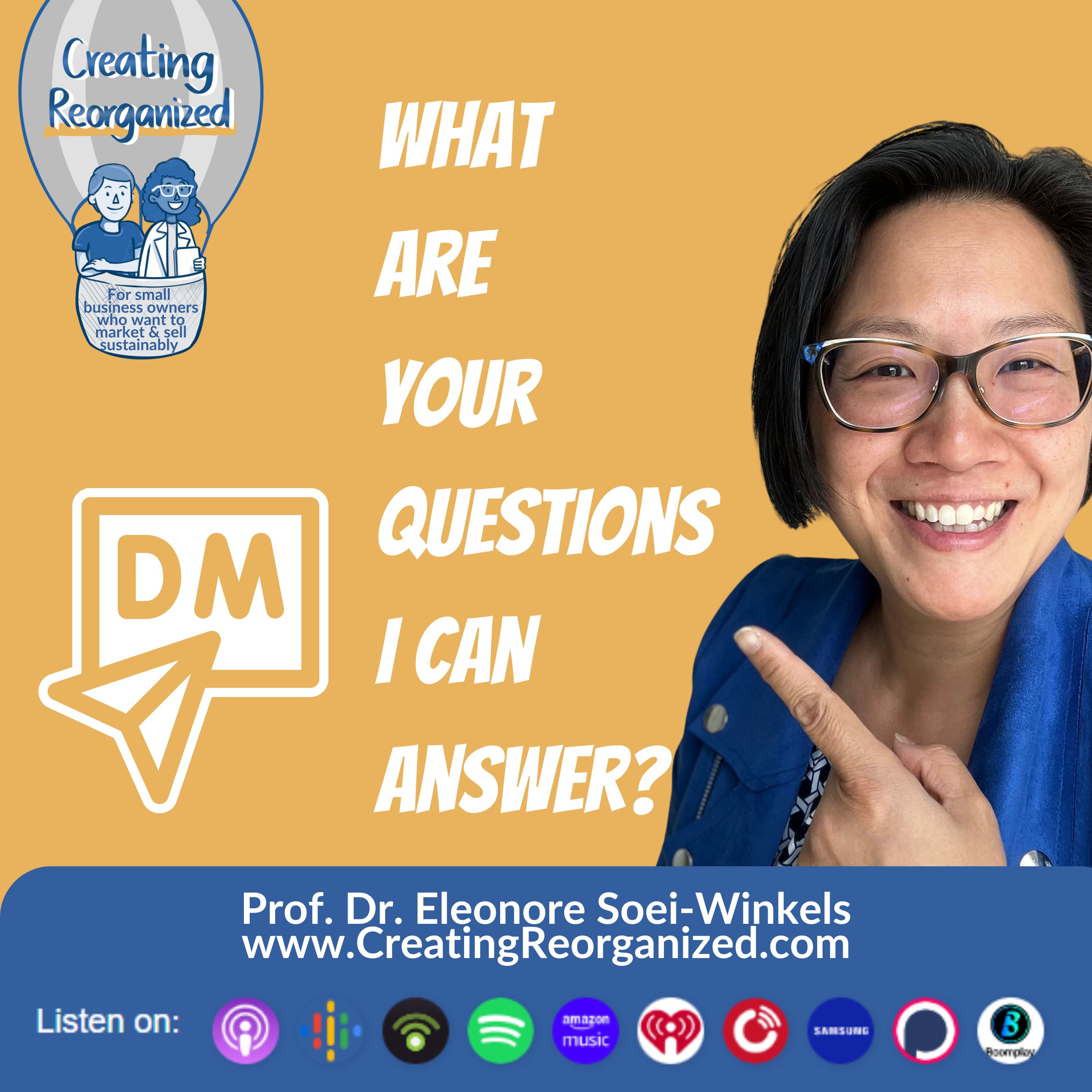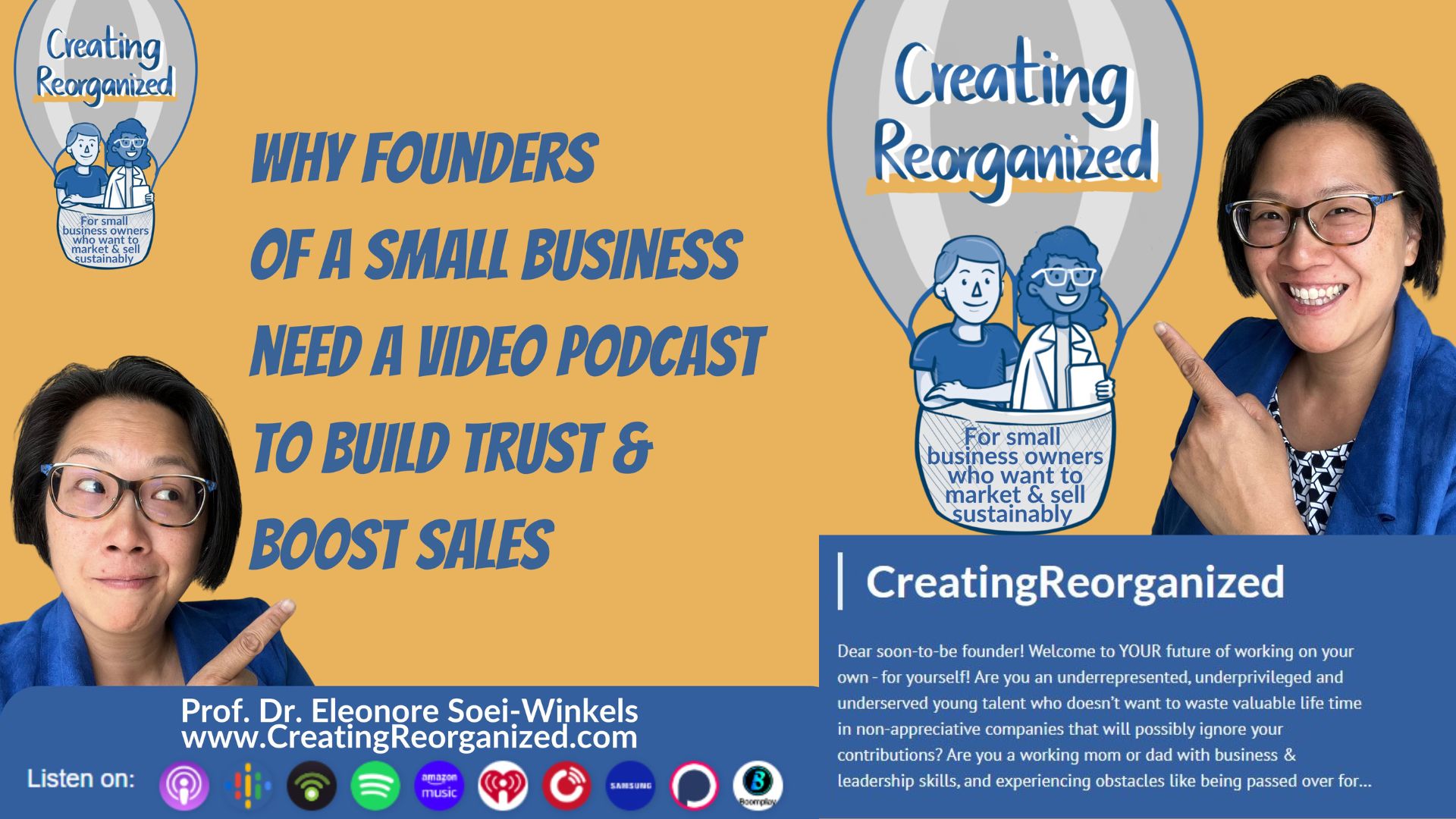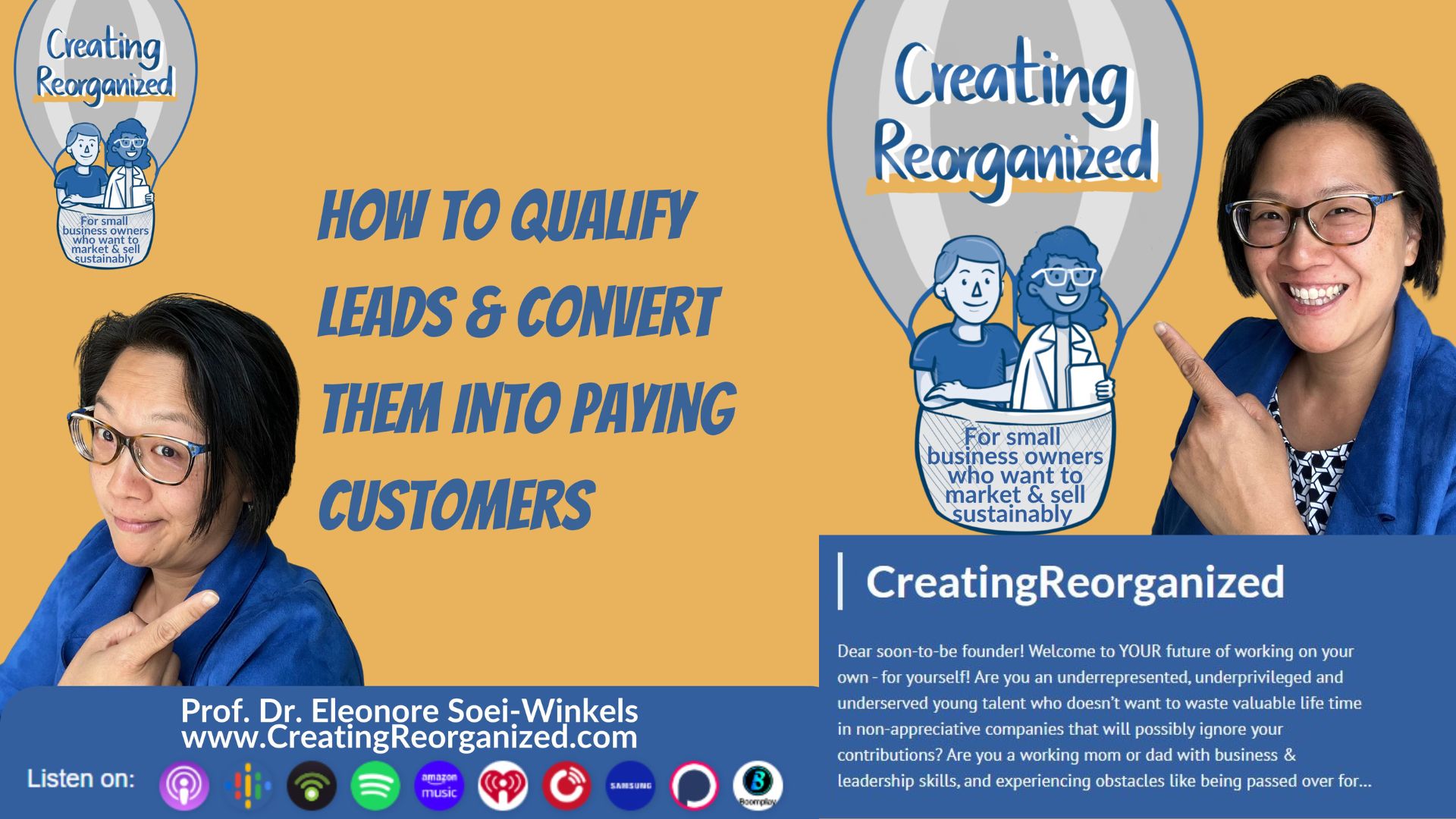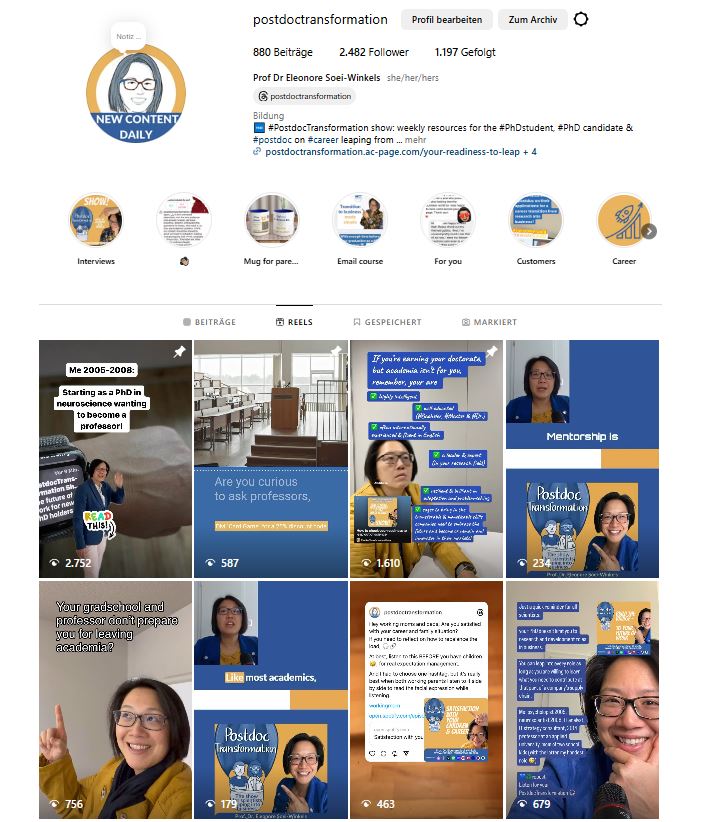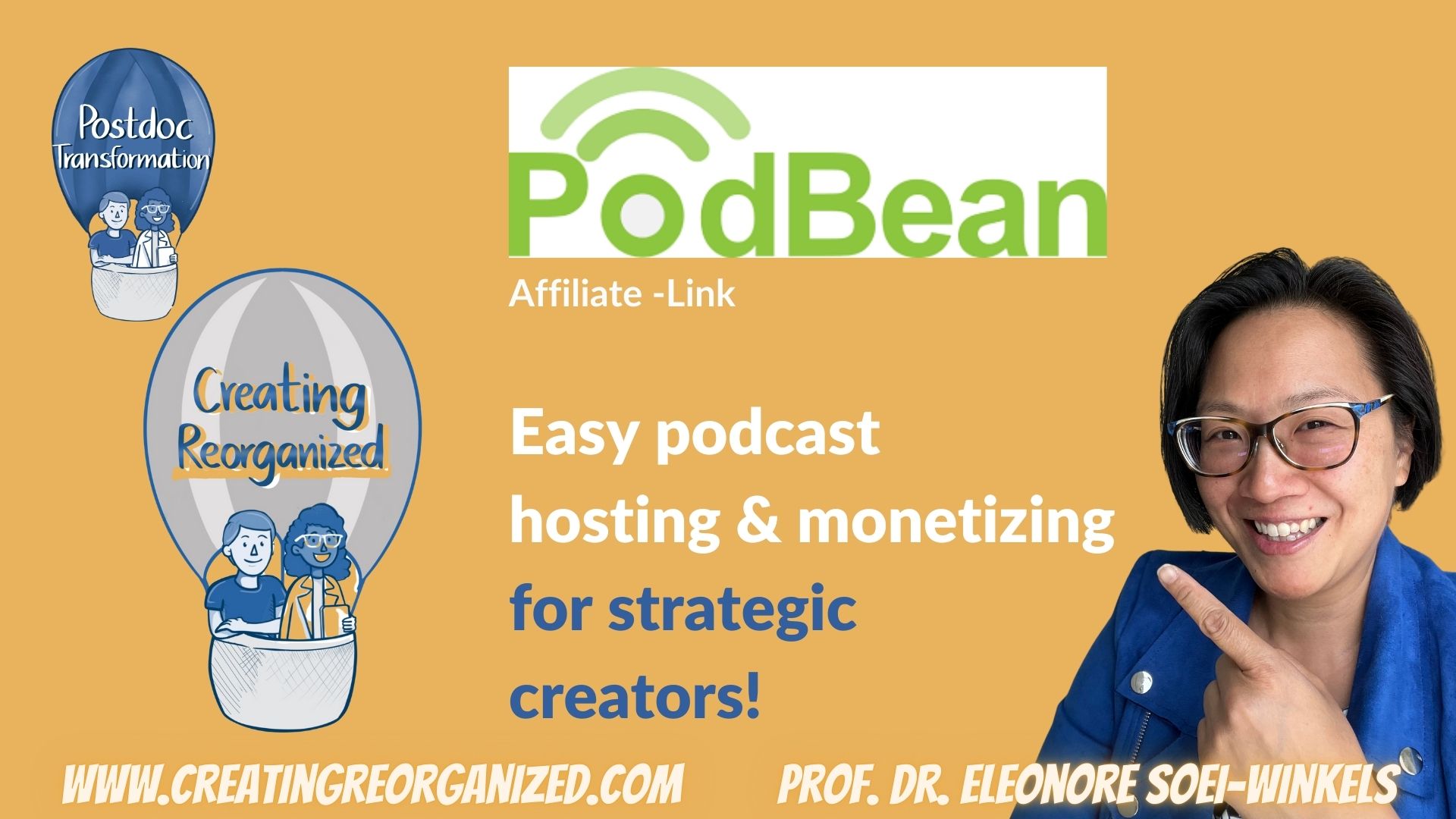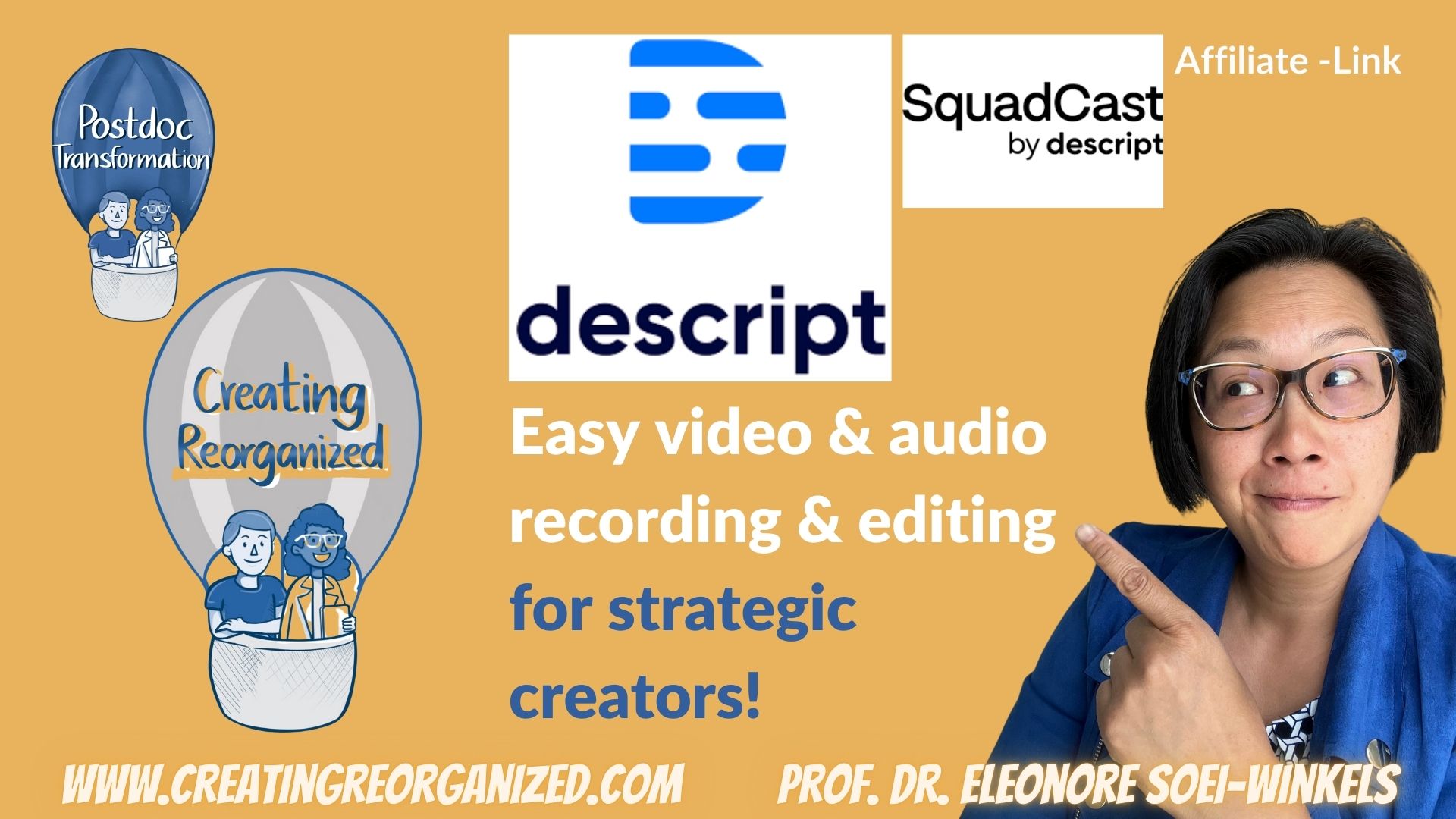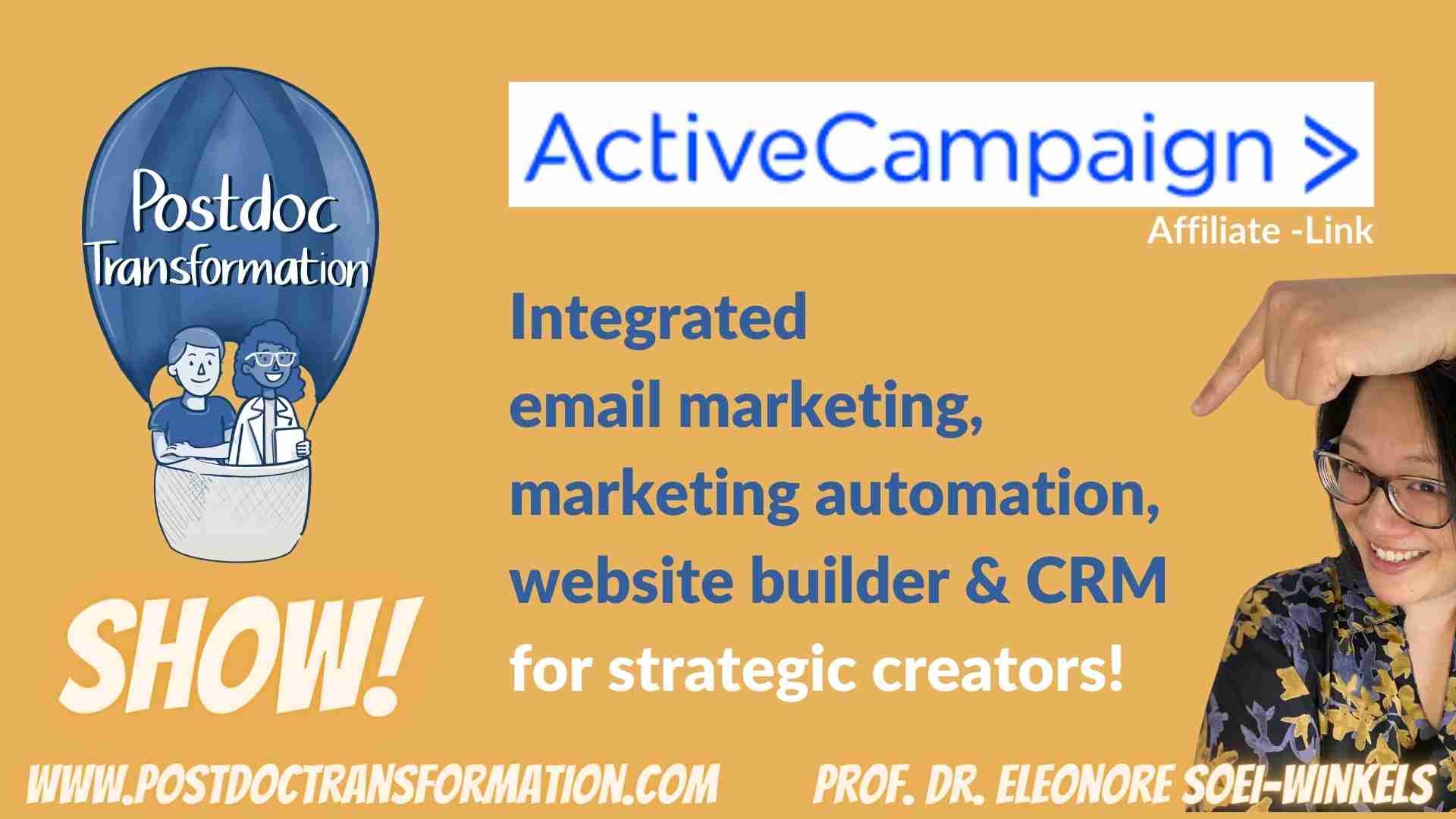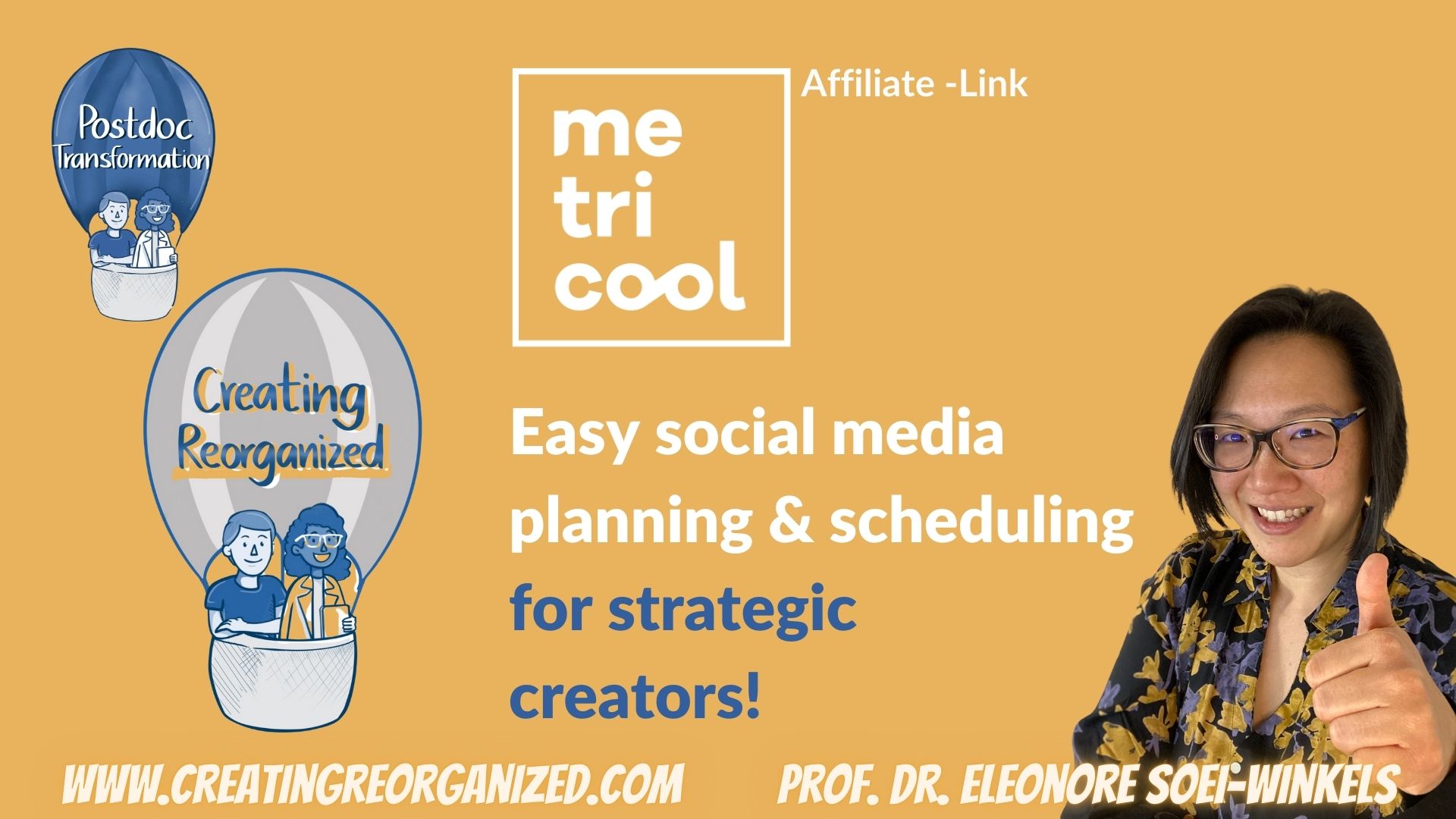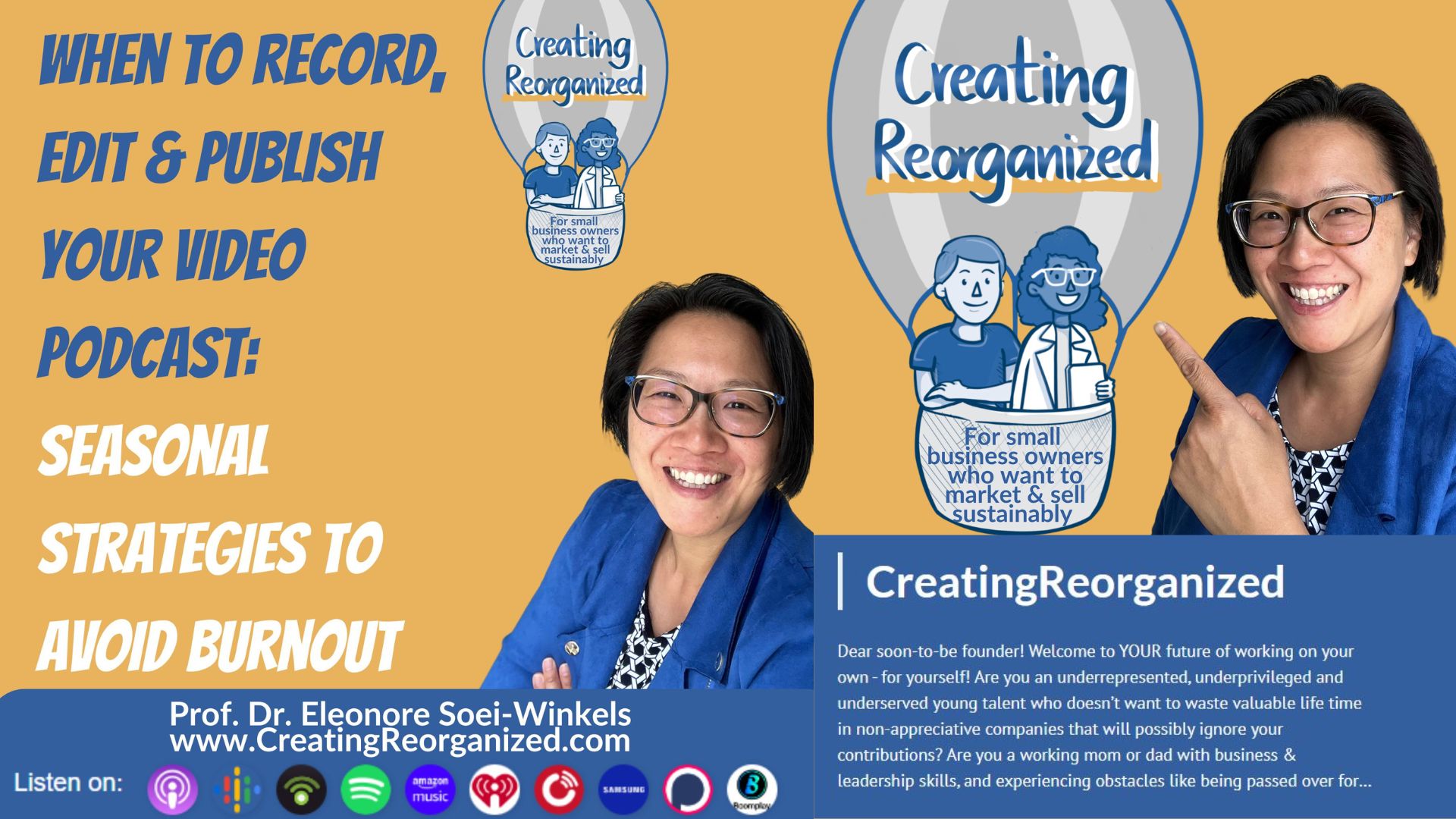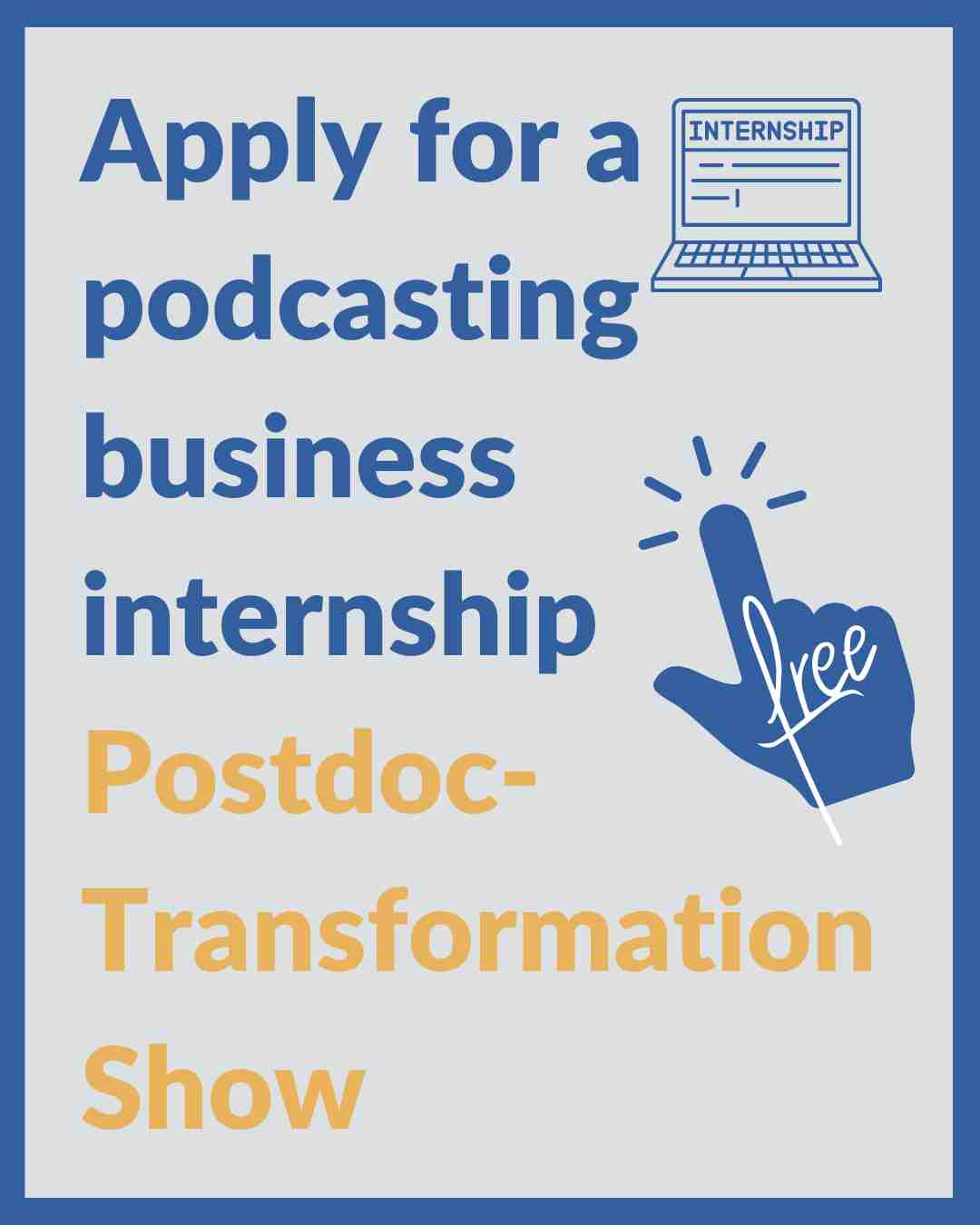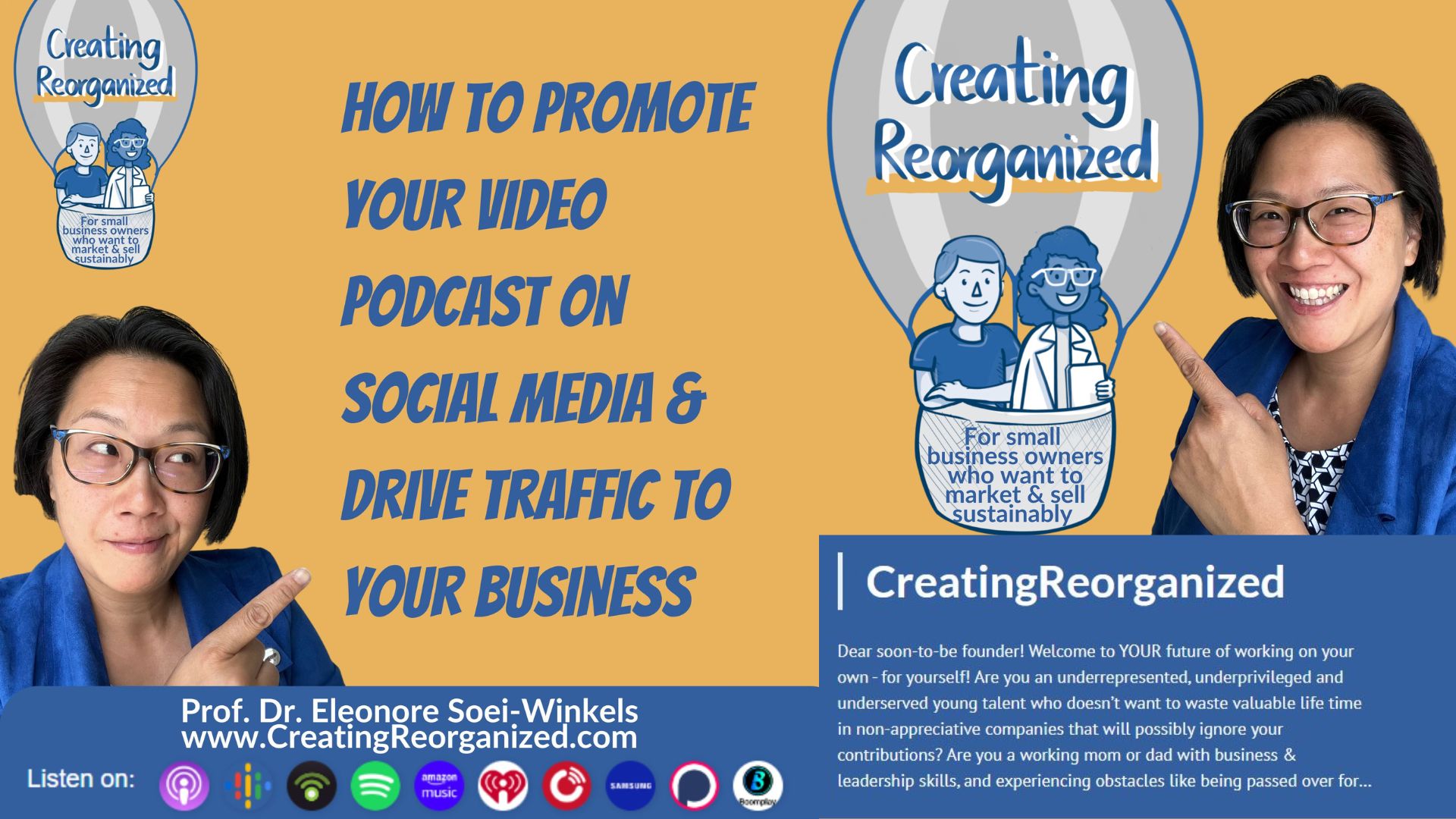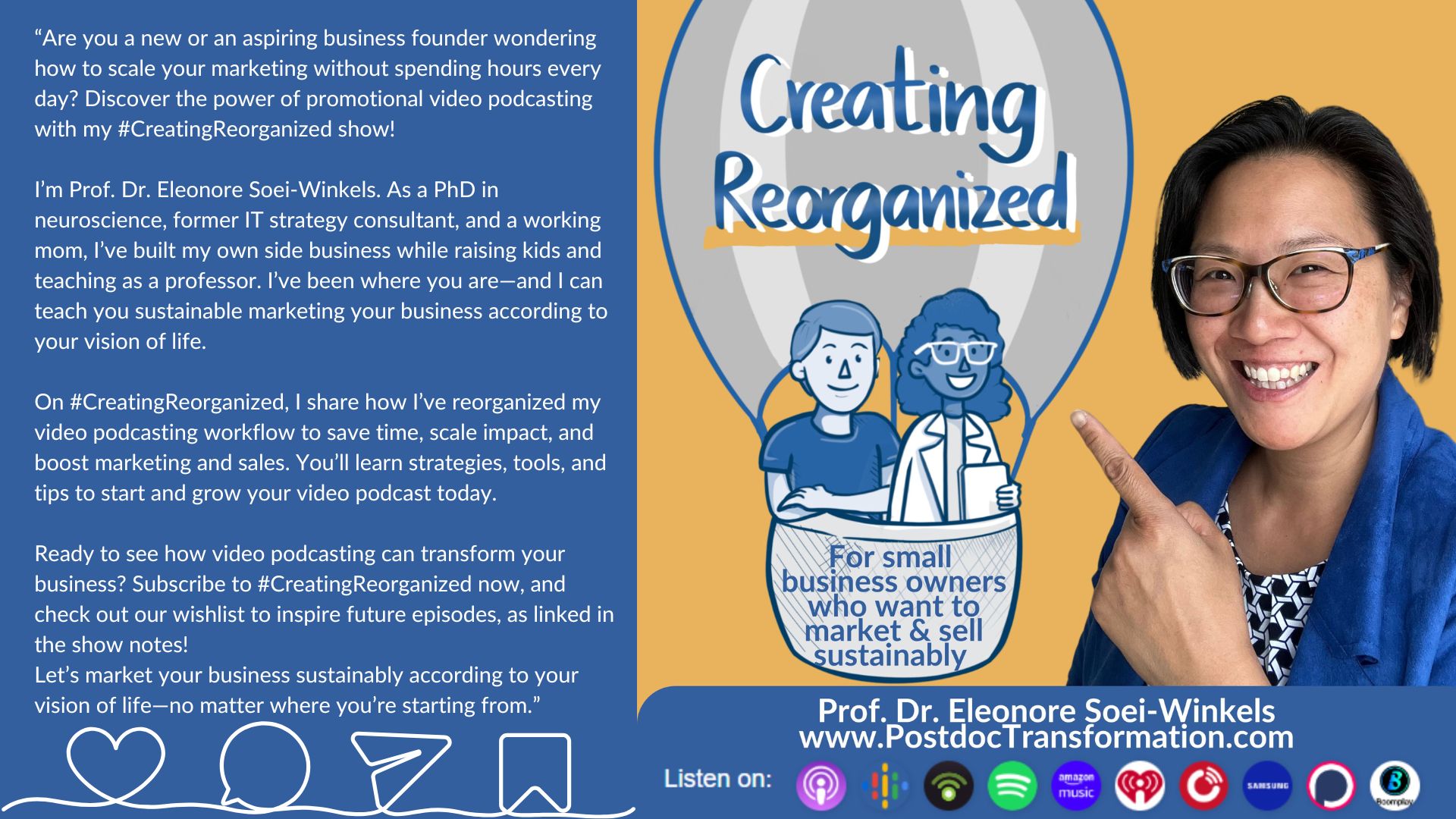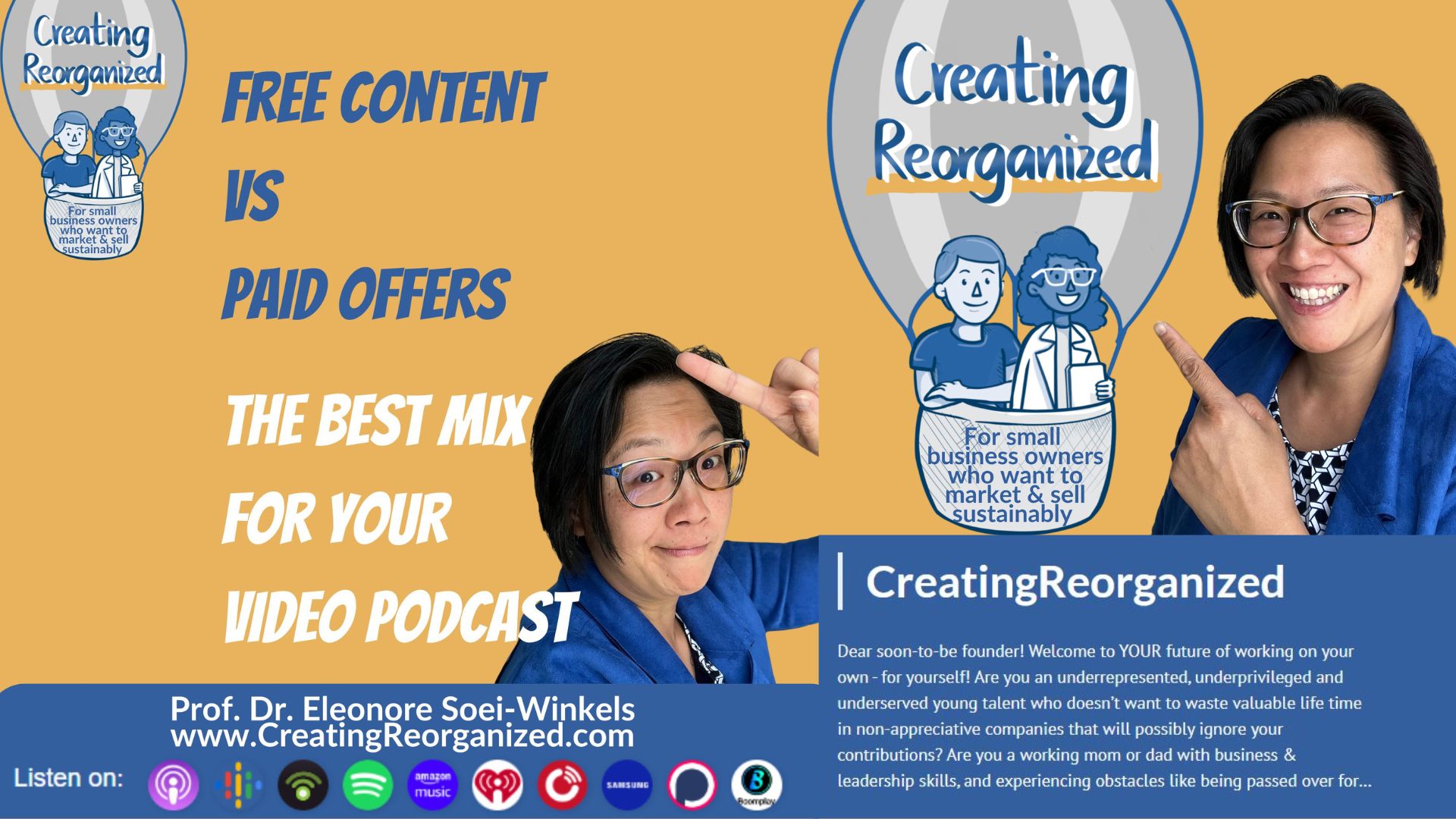
Free content vs. paid offers, the best mix for your video podcast, CreatingReorganized show
In this episode of the #CreatingReorganized show, you’ll discover the best mix of free content and paid offers for your #videopodcast. Prof. Dr. Eleonore Soei-Winkels discusses vital strategies for small business owners and content creators to maximize the value of their video podcasts.
The episode covers key concepts, including why #freecontent is essential for building trust, how to effectively differentiate free content from #paidoffer, and strategies to balance generosity with profitability.
Prof. Soei-Winkels shares expert insights on leveraging psychological principles like #LossAversion and the #ZeigarnikEffect to keep your audience engaged and drive conversions. She provides actionable tips on structuring your video podcast to hook listeners and guide them toward your paid services seamlessly.
By the end of the episode, you'll have a clear plan for using your free content as a #leadmagnet, setting up a #valueladder, and creating a sustainable content strategy that grows both your audience and revenue. Tune in for practical guidance tailored to elevate your business #marketing through strategic #videopodcasting.
If you are a new or aspiring founder of your small business and have no time to waste, or really struggle to do your social media marketing, you will enjoy our #CreatingReorganized show!
In my day job as a psychology professor I teach my bachelor and master students in real life, how to reorganize processes in a goal-directed and future-proof way in companies. That’s what I had done for a living as a former IT strategy consultant.
For my own career coaching business on the side, I can only dedicate a fraction of my time – because I prioritize care work for my little children. I face the same or similar challenges like all small business owners. So, I applied all my experience and knowledge to create my other video podcast #PostdocTransformation to streamline my social media marketing and to boost sales of my coaching, e-courses and affiliate products or services.
I strategically capitalize on professional tools to scale my impact according to my vision of life.
Listen and subscribe to this #CreatingReorganized show, so you will learn to do the same for your own business, to build the know, like and trust factor and to boost sales of your services or products!
Please also ask your business-specific questions, because for season 2, I envision interview episodes with aspiring and new founders like you, if you want to get your #CreatingReorganized according to your vision of life!
[00:02:15] Hello dear CreatingReorganizer and welcome back to our show Creating Reorganize! Today's topic is one of the trickiest questions content creators face: free content versus paid offers. How much to share for free? Well, when you are building a video podcast as your 24/7/365 business marketing arm. You will want to provide your audience with valuable insights, so they see you as an authority, but you also need to save enough value to make your paid offers irresistible.
[00:02:45] In this episode, we'll dive into
1) Why free content is essential for building trust and authority.
2) The difference between free and paid content and how to draw the line.
3) Strategies to balance generosity with profitability.
4) Actionable prompts to apply these strategies to your video podcast right away.
5) Psychological models, theories, or concepts that dovetail nicely with balancing free versus paid offers.
By the end of this episode, you'll have a clear plan for structuring your free video podcast content as a shareworthy lead magnet so it naturally leads to conversions.
[00:03:26] Let's get started with CreatingReorganized.
1) The role of free content in building trust
You can ask me, why should you share anything for free in the first place? It's simple. Free content builds trust. According to the marketing theory, the know, like, and trust framework, people buy from brands they know, like, and trust. Your video podcast with you as the face and the voice, being the personal brand behind your business, is the perfect medium to achieve all three. They get to know you, trust you, and to like you as a personality.
[00:04:02] Let's talk about the know factor. So that is consistent free content that makes you visible and audio to your audience with regular episodes and daily short form content on your social media platforms. Your voice, personality, and insights help listeners connect with you because people buy from people, not from non-personal brands. You make a difference in the sea of indistinguishable knowledge. That is also why all the big brands try to work with influencers who are then personal and relatable to their audience.
[00:06:39] And now it's about trust. Sharing valuable advice without expecting anything in return, establishes your credibility and that hopefully reminds you on the reciprocity principle, which we have already highlighted in our previous CreatingReorganized episodes. For example, how to promote your video podcast on social media and drive traffic to your business as linked in the show notes if you haven't listened to it yet.
[00:07:05] But here's the catch. Free content is a hook, an appetizer, but not the whole meal. If you give too much away for free, people won't feel the need to pay more.
[00:07:17] So let's think about some variations of what your free content could be.
Supply chain
[00:07:23] A think about your supply chain, before non followers who are a cold audience, unconscious about your business, can become your ideal client avatar, they may have to finish something else before. For example, in our PostdocTransformation Show for scientists leaping into business, we target postdoc scientists.
[00:07:44] Speaker: So these are researchers with a PhD who must do a career transition as soon as possible if they decide to do so. But we also target PhD students who can ask their graduate school to book our career transitioning services. So of course I created some episodes targeted to potential incoming and ongoing PhD students, not just for after the PhD.
[00:08:11] I even have a couple of episodes for the best bachelor and master graduates to raise awareness for my free PostdocTransformation content. In our last episode, we talked about casting a web, right? So now we are expanding our web to get more traffic from a few foreseeable routes.
Predecessor audience size
[00:08:28] B. Think predecessor audience size. Okay, so another reason is you can also think of the size of your target audience. So, often the predecessor audience is bigger. In my case, of course, there are more PhD students than postdocs. There are more master's students than PhDs, and there are more bachelor students than masters. When I reach more predecessors, I have a bigger audience size.
[00:08:54] Hence you can gain more attention on more people by creating shareworthy free content for their future of work. You are essentially paying forward in a strategic way.
[00:09:06] And in our case, I can trailblaze as a professor who inspires the forthcoming generations of experts and leaders of all our children even if they don't become scientists who need my help to leap into business. They can still benefit and capitalize on the content that I offer them for free.
[00:09:25] Also, to pivot strategically and organically if your business model with your target audience crumbles, you can quickly create new services and products for the predecessor audience as you have already warmed them up for free. And here the reciprocity principle kicks in, they are already grateful that you have considered them in the first place, even though they were not your target group.
Value Ladder by Russell Brunson
[00:11:57] Now let's go to C. Think long-Term Value Ladder by Russell Brunson. Okay, I'll start with an example. If you can afford that, you can seed for high ticket sales later.
[00:12:10] For example, I'm a trained systemic management coach, and I coach leaders, but for most scientists who are currently working under precarious conditions, it's not affordable to pay for my one-on-one coachings. I have a too high ticket for them, but as I consistently help them for free to leap into business, yeah.
Even if they don't ask the graduate schools to book my paid career transition resources, once they are on my email list, I do my best to become top of mind for when they will need a coach later down the road also. It's foreseeable that you will have served a growing portion of your audience successfully and they develop with you.
Maybe they are now ready or soon will be ready for their next step. And it honestly would be a shame if you would have to recommend them to your adjacent next level competitor unless you have an affiliate link for bringing them new sales or so, so you can think of creating a value ladder service or product portfolio, so that way you can move your audience, your leads, your clients from earlier to later stages.
What are your low hanging fruit?
[00:13:20] So let's talk about D. Think about low hanging fruits as your first free content. In your video podcast, you can repurpose talks or workshops that you have already given or even just repackage without substantial new preparation. From which you can then naturally derive and develop paid offers, which you can then offer at the end of your episodes.
Qualify your leads
[00:13:43] And then E, all of your free content topics can and should also qualify your leads. If that doesn't ring a bell, I recommend listening to our previous episodes, how to qualify leads and convert them into paying customers as linked in the show notes.
[00:13:58] Speaker: Last but not least, think about a format that is ideally set and forget. What do I mean with that? As you may know, before I was appointed as a professor for industrial and organization psychology, I worked as an IT strategy consultant, and hence, I always want to scale my impact.
[00:14:19] I can't serve for free investing a lot, and more importantly, in an ongoing or recurrent effort, my time is too valuable for me, so all my favorite tools are digital. For example, I can use a quiz to which I can direct code leads via a trackable link, and I will share that in my next example.
[00:14:38] So stay tuned or an email course through which I can track the open rate and click through rate from one email to the next. I created my AL email course for a career transition made simple in ActiveCampaign as linked in the show notes.
Both having common that you are involved in the beginning and then you can set up the tech to work as your digital assistance, while you can focus on other areas of your life or business and your cold audience is served with your free but valuable content.
And lately I even have set up my social media to be also free content in a scalable way, thanks to my social media management tool of choice which is Metricool.
[00:15:20] Okay, so we've been talking A to F and now I wanna share an example from my PostdocTransformation Show. I have this free content check your readiness to leap out of signs, which are 15 yes and no questions with an automated score result via email.
[00:15:36] First, I created a quiz with scored questions and yes, no answers in TypeForm, which is my tool of choice to communicate with my leads and gather information across the client lifecycle. Then I recorded the first audio podcast episode. Back then, it was merely an audio podcast.
[00:15:54] Speaker: I have to be honest, so the podcast episode by itself is already viable. I also mentioned the free check your Readiness to Leap Out of Science quiz with more information and explanation for each of the 15 questions. Okay, so I have two lead magnets there.
[00:16:11] I have the quiz and I also mention it as a podcast episode, and I link both of them. Once someone is listening to the PostdocTransformation show in the first episode, if they are interested, they will also click on the quiz to get more information. Taking the quiz is already valuable for the scientists leaping out of science. But if the quiz taker now wants the final score and all the questions in a convenient email for further reflection, he, she or it must enter an email address and hence gets on my email list, where I can then continue to build the know, like, and trust factor within subsequent emails.
[00:16:50] I'll link to that and to my other quiz in the show notes so that you can study my examples and adapt it for your own business.
[00:18:32] But your whole video podcast can also be free content, of course. Every video podcast episode is organically interrupted with my ads, my advertisements for my paid offers, and my affiliate links. I have a 100% retention rate for most weeks of an ongoing season, and the secret is: I need to be valuable enough in my content so that they keep listening until the end of the episode.
[00:18:57] And here's your actionable prompt. On a sheet of paper or a blank slide, I want you to list your supply chain, at least the steps before and after your main business model, your predecessor target audience, and the value ladder. easy to repurpose content and ideal topics that qualify your cold audience to become your ideal client avatar. And looking at your information, I want you then to brainstorm one piece of free content, and ideally, your product or service is the natural, subsequent premium paid offer.
[00:19:35] And if not, you can derive an idea for a new service or product in your pipeline. And that being said, you can have a handful of free content or lead magnets as they are called in marketing, as they magnetically attract new leads into your world. And once you have your content ideas, think of the format that is ideally set and forget. You will thank me later.
[00:19:59] Let's go to part two.
Balancing Free and Paid Content
[00:20:00] Differentiating free content from paid offers. How else can you decide what's free and what's paid? The answer lies in creating a clear boundary between what you teach and how you teach it. What you teach can be free, but how you teach it should be paid.
[00:20:17] Number one, free content should focus on what your audience wants to know now and save what they really need to know for later in your marketing funnel. They don't know what they really need to know, but they want to know X and that is what you deliver in your hooks, in your social media content, in your video podcast for free.
[00:20:40] This might include high level overviews of a concept, quick tips, or small wins they can implement right away, actionable tips, right? Industry trends are why they should care about a problem. You can raise awareness for free and then get paid to help them solve the problem.
[00:21:01] Here's an example. A Fitness Coach video podcast might include three episodes, like, five foods to boost your energy. That is the what. And then the paid content could be the how. The paid content is about how to achieve the deeper transformation because it's not just about the food.
[00:21:19] It should include step by step processes for your workout, advanced strategies for your diet and lifestyle, personalized tools and templates, and maybe even one-on-one support. The same fitness coach could sell a paid course titled the 30 Day Energy Reset Program, and that is the how.
[00:21:38] Another example is if you offer software as a service, you can offer free features and a premium feature, if your client wants premium features, they need to unlock them by paying a reasonable price.
[00:21:50] And in my case, in my paid career transition workshops and memberships, I offer one-on-one feedback for CV improvement, review of job ads and tailored applications, contracts, review and salary negotiations. I don't offer that on my podcast. Why should I? I can't do this. It's a one to many broadcasts, so to speak, but I mention it. That way, I raise the awareness that they will have problems with that, and then I'm top of mind.
Create your own value ladder
[00:23:33] Let's revisit a marketing theory already mentioned; the value ladder by Russell Bronson. So a value ladder explains how businesses guide customers from free offers to increasingly valuable and expensive paid products. The free content sits at the bottom of the ladder and builds trust while premium offers are at the top and drive revenue.
[00:23:57] So here's your actionable prompt. Create your own value ladder. So here's the first rung, a free video podcast episode to raise awareness with shareworthy value. Shareworthy, so everyone in your audience can share that with their friends so that you get awareness even more so. On the second rung offer an affordable workshop once a year, twice a year, or every quarter to tease scarcity, and also as your entry level service of product. And then at the top rung of your ladder, you can have a high ticket offer, and that is a one-on-one coaching or your premium service and product.
[00:24:36] So at best you can save your previous notes from a couple of minutes, you can come back to them and see the next step or rung of your value ladder because your audience, your clients develop with you, and then they are hungry for more working with you again and again.
[00:24:52] Alright, part three, balancing generosity with profitability. Okay? So we need to talk how to strike the right balance. Okay? You cannot give away, away, away. And then you are ending up bankrupt, you want to give away enough value to attract and retain looseness, but you need to leave them wanting more.
Sign up to our CreatingReorganized inner circle newsletter, where you can learn and apply my tactical tricks to your marketing challenges and see how business podcasting can help you strategically to reach your goals
Sign up now via this form (made in ActiveCampaign):
[00:25:11] And I suggest a 50:50 rule. So a good rule of thumb is to offer 50% of your knowledge based value for free and reserve, 50 for your experience based paid offers, because others may recommend 80 20. But for your own personal wellbeing, your mental health, I want you just give away 50% for free and leave the other 50% for the paid offers because that is where you have enough energy to focus on the people you can serve. You don't have to give all your content for free right away, but instead in your one-on-one coachings, you can give and tease and seed a lot of things for free, and then still capitalize that later down the road.
[00:25:56] It's just that you don't give everyone randomly for free everything that you have. 50% is knowledge based value for free, and the other 50% are for your experience based paid offers. In the era of AI, knowledge is cheap, but experience is key to digest and strategize in a goal direct way. People need guidance today more than ever people with problems don't have the expertise to judge whether the AI is offering them something of value or not. It all sounds great. It all looks great. It's a new shiny object, but they need a human leader to help them walk the talk, walk what they are reading on screen, or what they're listening created in an artificial way.
So this is really when you can provide most value for which your human clients will want to pay. We have an information overflow, and if you can provide actionable leadership, your clients will follow you.
[00:26:59] So in short, your free content could be insights, teasers, and starting points. But your paid content could be detailed guides and exclusive tools or advanced techniques. The icing on the cake could be individualized service or customized products. And that takes a lot of your own time, right?
[00:27:17] That's why you should be really generous with your free content, but very highly selected regarding who you want to cater for the paid offers.
[00:27:28] So for example, if you are a productivity coach, your video podcast might include for free top three apps to boost your productivity, then you can have a paid offer, like exclusive notion templates to organize your work week.
[00:27:42] You can use teasers and upsells. Think of your video podcast as the introduction to a bigger, more valuable experience. My PostdocTransformation Show is an example of how I do that. I dovetail my paid offers into the content of a given episode, and I have ads to my paid offers, which I have inserted every couple of minutes in every episode.
For example, teasers could be, share snippets of your paid offer and happy clients. Testimonials if you have, and upsells could be in each episode with a call to action directing listeners to your product or service.
[00:28:17] So if you are a business coach, you might conclude your video podcast with if you want the complete toolkit for starting your own side hustle, check out my Side Hustle Starter kit. It's only available for 100 days before we raise the prices, and that really leads me to the next point.
Build scarcity and urgency
[00:29:58] You have to build scarcity and urgency. Encourage listeners to act. Humans are lazy. We are all lazy, and they don't have a pain point or no urgency to overcome that obstacle, then they don't buy your solution. So you need to paint the future out of what would happen soon. Something negative if they don't capitalize on your solution.
Some scarcity examples that could be discounts for a limited time for the founding members of your new service or early birds of your product. And see what I just did here in both examples, I gave a reasonable positive reason for the urgency and scarcity.
[00:30:36] People don't like to be pushed without reason.
[00:30:40] Here's another example. An interior design podcast could promote this week only save 20% on a home design masterclass this week only. So be quick.
[00:30:52] here's a actionable prompt. I want you to identify one video podcast in your archive or that you wanna script out and add a teaser for a related paid offer.
[00:31:04] If you don't have one, create a downloadable resource, like a PDF checklist or a template to upsell or whatever. Just try that out because alone with link, you can see whether people are interested in buying in already into your journey as you helping them solve their problems.
Structuring Your Video Podcast for Conversions
[00:31:26] Alright, part four, how can you structure your video podcast for conversions? You need to think about how you can hook your audience early, okay? So you wanna hook them from social media, but you also want them to be hooked to listen until the end of the episode. Start with a quick teaser about the free value they will receive. And mention your paid offer upfront.
[00:31:50] This way it's a fair trade off. You'll promise and deliver the bulk of your free value first, and then before the last bit of your free value delivery, you can then promote your paid offer and close with a free value because otherwise you will see a drop out or abrupt stop of listening in your statistics once you start talking about your paid offer.
[00:32:12] Because then of course your audience could have walked away with 100% of your free value and they might feel grateful, but they don't have time endlessly, right? So they're not necessarily waiting to listen to your ad.
[00:32:25] Okay, so here's an example. Today I'll share three tips of boosting sales, so stick around under the end of the details of my sales master workshop, something like that. All right? Then you can use storytelling to highlight your offers. You can always weave in stories of transformation tied to your products or services.
[00:32:46] For example, one of my clients applied this strategy and saw a 30% increase in revenue. Do you want the exact templates she used? They are available in my course, and I will link to that in the show notes. Rely heavily on storytelling, and this is what makes similar offers, distinctive and emotional insights stick.
[00:33:08] Okay, in my CreatingReorganized, I have a fixed structure for how I promote my ings to all services you would want for your video podcast. For example, Podbean, Descript TypeForm, Thinkific, ActiveCampaign and Metricool. And if you are listening closely, I have a storyline that runs through all of them in that specific order.
[00:33:30] So if I have a new listener who doesn't know my episodes yet, at least the ads are also informational for them. So they are easier to accept. And in every ad I teach something. So that's why I have a storyline that runs through all of them in that specific order.
[00:33:50] And all of my free content in between are derived and anchored in an overarching storyline for a season. So I have many through lines in every episode, but also across this season. Each section between ad number one and ad number two is structured similarly so that I can naturally interrupt with an ad with being too intrusive, and that's probably the reason.
[00:34:15] Why I have a 100% retention rate from start to finish of an episode, and also from episode to another within an ongoing season, be it the PostdocTransformation Show with almost 10 K downloads, or the CreatingReorganized show, which we have just launched.
[00:34:32] And I share in the show notes my screenshot from my Podbean analytics to prove that I have a 100% retention rate.
The structure of the video podcast episode
[00:36:09] Okay? And for the structure of the video podcast episode, you need to close with a strong call to action. That applies to shorter episodes, and one could argue what is short. Typically, video podcasts episodes are like 15 to 30 minutes, but for our CreatingReorganized show, we intentionally have about one hour episodes and we strategically repurpose the cutouts for social clips and carousel image posts. So for me, I also think long term, it's not just this one episode, but it's also the cutouts that have to be standalone.
[00:36:48] And that's why we also have call to actions almost in every section between the two ads. Regarding the length. Consistency is key. If you have your listeners already primed for one hour episodes, don't switch to half an hour or, suddenly be longer than expected.
[00:37:07] So more important than length is if they know what they get, they can take time to digest your content. And if you have longer content, like one hour, it's also advisable to have chapter markers so that every couple of minutes, I have the chapter markers updated so that you can jump from one chapter to another.
[00:37:26] I'm thinking repurposing, so I set everything up for being repurposable from the get go.
Psychological models, theories and concepts:
Loss aversion and the Zeigarnik effect
[00:37:34] As always, let's end with a psychological model, theory or concept that dovetails nicely with what we have already discussed in terms of free content or paid offers- The best mix for your video podcast. I'm going to introduce you to two fascinating psychological principles that will help you structure your free and paid content in a way that naturally makes sense so that people want more.
[00:37:57] We're talking about loss aversion and the Zeigarnik effect, which are two models that deeply influence how your audience thinks, and more importantly, how they buy. So let's break them down and show you exactly how to use them in your video podcasting strategy, CreatingReorganized.
[00:38:15] Okay, so number one, loss aversion. Why people hate to lose more than they love to gain. So this concept comes from the Prospect Theory developed by Kahneman & Tversky, 1979. Here's the core idea. People feel the pain of losing something twice as strongly as they feel the pleasure of gaining something. So let me put it this way. If I gave you $100, you'd be happy. But if I now took $100 away from you, you would feel significantly worse than the happiness you felt from receiving it in the first place.
[00:38:51] Now, what does it mean for you as a small business owner creating a video podcast? It means your audience is more motivated to act when they fear losing out on something valuable. So here's to apply that in your video podcast.
[00:39:06] Number one. Make your free content viable, but hint at what's missing. Let's say you're a business coach offering strategies to scale a service-based business in your free content. You can share three out of the five key strategies, but you'll make sure your audience knows that they're only getting part of the full system you might say, so I've just walked you through the first three strategies that have helped my clients double their revenue. But here's one more thing. There are two more steps that really brings this together, and that's what I cover in my full workshop.
[00:39:38] You can also use time sensitive offers to trigger loss aversion. So if you have a paid course membership or coaching program, you can create an urgency based offer tied to your video podcast. For example, this bonus training is only available until Saturday. If you buy now, you will even get a bonus, which is only available until Sunday, and after that, it goes back into the vault.
[00:40:00] So this is a first time offer. If you buy now, you'll get an extra bonus for free, but you have to be quick. So the thought of losing access makes people act faster. They are under pressure to not lose even more, and that's why they wanna buy now.
[00:40:15] And then you can also frame your paid offer as a way to avoid loss. So instead of join my program to learn X, y, Z, you can say, if you don't take action now you might keep struggling with your problems for months and months, but others who invest in this program will already be seeing results.
[00:40:36] People hate the idea of being left behind. So make sure your messaging taps into that. Now if you think that's powerful, wait until you hear about the second psychological effect that makes people crave closure.
Zeigarnik effect
[00:41:53] Let's talk about the Zeigarnik effect. Okay, so why unfinished stories stick in your head. When you have a to-do list, you remember that there were a lot of things to do. And you are, you know, satisfied with ticking off the chores. And then if you have one thing left that really bugs you all night long, right?
[00:42:16] See? Or another example, when you're watching tv, a series, leave you with a massive cliffhanger at the end of an episode, you can't stop thinking about it, so you read everything.
[00:42:27] So that's called the Zeigarnik effect, which is named after the psychologist who discovered in the 1920s that our brain fixates on unfinished tasks or incomplete information. So, when something feels unfinished, our minds keep coming back to it until we get closure. And guess what? You can use this effect strategically in your video podcasting to make sure that your audience can stop thinking about your content and wants more.
[00:42:54] For example. End your free content on a strategic cliffhanger. Let's say you teach a digital marketing course in your free video podcast episode, you could walk them through part of the strategy and then stop just before revealing the most crucial step. You could say we've covered the first half of the system, but there's one more step that brings everything together, and that's what I will show you inside my exclusive membership. This creates a natural pull towards your paid content.
[00:43:26] And you can also use storytelling techniques to leave gaps, right? You can tease in the beginning and then say you will finish that later.
[00:43:34] For example, you can start a success story about one of your clients, and then you can pause and wait until the grand finale to reveal the final transformation at the end of the episode, so this way it will be a running example. An example here, when Sarah started using my framework, she struggled at first. There was, one thing she hadn't implemented yet, but once she did, everything changed. I'll break down exactly what she did in the bonus training.
[00:44:04] Now. Your audience needs to know what's coming next, right? They want to know because they are in Sarah's shoes already, so now they want the solution.
[00:44:13] You can also split your content into a free to paid sequence. You can record a miniseries where your free episodes lay the groundwork, but the final crucial piece is inside your paid program.
[00:44:24] So let's recap. Loss aversion makes people act when they feel they might lose access to something valuable. And you can use this by giving away high value, but clearly signaling what's missing. You can create time sensitive offers, and you can also frame your paid content as the way to avoid missing out.
[00:44:43] And the Zeigarnik effect, well, that's your secret weapon to keep your audience engaged and craving for more. You can use it by ending your free content on a strategic cliffhanger, using storytelling to keep people hooked and structuring your content as a free to paid sequence.
[00:45:01] So now I want you to think about what's one way you can tweak your video podcast episodes to build anticipation and increase conversions?
Conclusion and Next Steps
[00:45:10] So to recap, balancing free and paid content is an art and science. You should share just enough free value to build trust and authority. You should clearly differentiate between free content from paid offers. Use storytelling teasers and call to actions to guide your audience to your paid services.
[00:45:30] And this way you create a sustainable content strategy that grows your audience, but also your revenue. And here's your challenge for today. Take one actionable point from today's episode and apply it for your next video podcast episode, and let me know how it goes by tagging me on social media. I'd love to hear your progress CreatingReorganized. There are even more psychological models, theories, and concepts viable to this episode of why, how, and when to offer free versus paid content, but that's what I teach in my upcoming Creating Reorganized Workshops to celebrate our first season. So keep your eyes peeled and join our Creating Reorganized newsletter to be the first to be invited to our workshops!
To celebrate this season of the Creating Reorganized show, I want to offer you a business podcasting internship for four weeks. You can apply or join the wait list for the next season for this treat by sharing why you want to do a business promotional podcast. What your services or products are. And [00:53:00] if you and your business are in line with my own values, I will strategize, conduct, and produce with you your first three episodes.
For the first one, I take the lead and you shadow me. For the second one, you do the work and I help you out. For the third one, you are on your own with me, cheering for you on the sidelines. For more details, click on the image below to send me an email and we will send you the application details.
Do you want to start your own site business as a runway for your better future? Then you will benefit from our free business readiness quiz as linked in the show notes. Are you a small business owner and want to create sustainable marketing and sales content? Try video podcasting about your service or product like I do in my postdoc transformation show.
I'm a mom of two kids in school and a professor and I have no time to lose running my business. And if you also want to save time and energy, use our dovetailed [00:54:00] evergreen strategy. You can easily derive countless valuable social media content from just one video podcast episode. You can quickly attract a broad audience across many social media platforms and then nurture them into leads and clients in their ears and emails while you live according to your vision of life.
Let me teach you CreatingReorganized. If you're ready to dive in and start your own podcasting journey, I highly recommend checking out the tools I mentioned earlier: podbean, Descript, Typeform, ActiveCampaign, Thinkific, and Metricool. Each of these services has made my podcasting business experience smoother and more efficient, and I trust that they can help you too.
Thank you for listening to our CreatingReorganized show. If you found this episode helpful please subscribe, share it with your business friends and leave a review on your favorite podcast player. Your feedback helps me as a small business owner to serve more small business owners for free. So thank you.
I'm your host, Professor [00:55:00] Dr. Eleonore Soei-Winkels.
And now I wish you a happy CreatingReorganized according to your vision of life.
